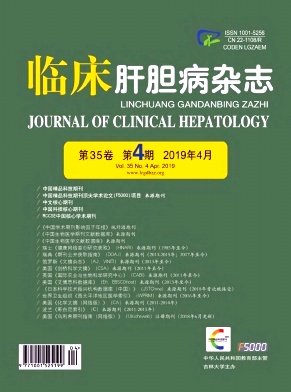|
[1]WANG FS, FAN JG, ZHANG Z, et al. The global burden of liver disease:The major impact of China[J]. Hepatology, 2014, 60 (6) :2099-2108.
|
|
[2]MU YP, LIU CH, LIU P. The theory of liver cirrhosis“deficiency and damage producing accumulation”:Professor Liu Ping’s academic thought[J]. Acta Univ Tradit Med Sin Pharmacol Shanghai, 2013, 27 (2) :1-4. (in Chinese) 慕永平, 刘成海, 刘平.肝硬化“虚损生积”论——刘平教授学术思想[J].上海中医药大学学报, 2013, 27 (2) :1-4.
|
|
[3]HENDRIKX T, SCHNABL B. Antimicrobial proteins:Intestinal guards to protect against liver disease[J]. J Gastroenterol, 2019, 54 (3) :209-217.
|
|
[4]SENDER R, FUCHS S, MILO R. Revised estimates for the number of human and bacteria cells in the body[J]. PLo S Biol, 2016, 14 (8) :e1002533.
|
|
[5]HARTMANN P, CHEN WC, SCHNABL B. The intestinal microbiome and the leaky gut as therapeutic targets in alcoholic liver disease[J]. Front Physiol, 2012, 3:402.
|
|
[6]LIN R, ZHOU L, ZHANG J, et al. Abnormal intestinal permeability and microbiota in patients with autoimmune hepatitis[J].Int J Clin Exp Pathol, 2015, 8 (5) :5153-5160.
|
|
[7]BHAT M, ARENDT BM, BHAT V, et al. Implication of the intestinal microbiome in complications of cirrhosis[J]. World J Hepatol, 2016, 8 (27) :1128-1136.
|
|
[8]D'AMICO G, GARCIA-TSAO G, PAGLIARO L J. Review Natural history and prognostic indicators of survival in cirrhosis:A systematic review of 118 studies[J]. J Hepatol, 2006, 44 (1) :217-231.
|
|
[9]GINS P, CRDENAS A, ARROYO V, et al. Review management of cirrhosis and ascites[J]. N Engl J Med, 2004, 350 (16) :1646-1654.
|
|
[10]BENTEN D, WIEST R. Gut microbiome and intestinal barrier failure--the"Achilles heel"in hepatology?[J]. J Hepatol, 2012, 56 (6) :1221-1223.
|
|
[11]WIEST R, KRAG A, GERBES A. Spontaneous bacterial peritonitis:Recent guidelines and beyond[J]. Gut, 2012, 61 (2) :297-310.
|
|
[12]NOLAN JP. The role of intestinal endotoxin in liver injury:A long and evolving history[J]. Hepatology, 2010, 52 (5) :1829-1835.
|
|
[13] SANTIAGO A, POZUELO M, POCA M, et al. Alteration of the serum microbiome composition in cirrhotic patients with ascites[J]. Sci Rep, 2016, 6:25001.
|
|
[14]Chinese Society of Hepatology and Chinese Society of Infectious Diseases Chinese, Medical Association. The guideline of prevention and treatment for chronic hepatitis B:A 2015 update[J]. J Clin Hepatol, 2015, 31 (12) :1941-1960. (in Chinese) 中华医学会肝病学分会, 中华医学会感染病学分会.慢性乙型肝炎防治指南 (2015年更新版) [J].临床肝胆病杂志, 2015, 31 (12) :1941-1960.
|
|
[15]Professional Committee of Digestive System Diseases, Chinese Society of Integrated Traditional Chinese and Western Medicine. Consensus on diagnosis and treatment of liver cirrhosis with integrated traditional Chinese and western medicine[J]. Chin J Integr Trad West Med Dig, 2011, 19 (4) :277-279. (in Chinese) 中国中西医结合学会消化系统疾病专业委员会.肝硬化中西医结合诊疗共识[J].中国中西医结合消化杂志, 2011, 19 (4) :277-279.
|
|
[16]ZHENG XY. Guiding principles for clinical research of new Chinese medicines[M]. Beijing:China Medical Science Press, 2002:143-148. (in Chinese) 郑筱萸.中药新药临床研究指导原则[M].北京:中国医药科技出版社, 2002:143-148.
|
|
[17]KANG Y, CAI Y. Gut microbiota and hepatitis-B-virus-induced chronic liver disease:Implications for faecal microbiota transplantation therapy[J]. J Hosp Infect, 2017, 96 (4) :342-348.
|
|
[18]WOODHOUSE CA, PATEL VC, SINGANAYAGAM A, et al.Review article:The gut microbiome as a therapeutic target in the pathogenesis and treatment of chronic liver disease[J].Aliment pharm therap, 2018, 47 (2) :192-202.
|
|
[19]WINTER SE, BAUMLER AJ. Why related bacterial species bloom simultaneously in the gut:Principles underlying the ‘Like wil to like’concept[J]. Cell Microbiol, 2014, 16 (2) :179-184.
|
|
[20]SHIN NR, WHON TW, BAE JW. Proteobacteria:Microbial signature of dysbiosis in gut microbiota[J]. Trends Biotechnol, 2015, 33 (9) :496-503.
|
|
[21]LITVAK Y, BYNDLOSS MX, TSOLIS RM, et al. Dysbiotic proteobacteria expansion:A microbial signature of epithelial dysfunction[J]. Curr Opin Microbiol, 2017, 39:1-6.
|
|
[22]SWIDSINSKI A, LOENING-BAUCKE V, VERSTRAELEN H, et al. Biostructure of fecal microbiota in healthy subjects and patients with chronic idiopathic diarrhea[J]. Gastroenterology, 2008, 135:568-579.
|
|
[23]RIVERA-CHAVEZ F, LOPEZ CA, BAUMLER AJ. Oxygen as a driver of gut dysbiosis[J]. Free Radic Biol Med, 2017, 105:93-101.
|
|
[24]CROXEN MA, LAW RJ, SCHOLZ R, et al. Recent advances in understanding enteric pathogenic Escherichia coli[J]. Clin Microbiol Rev, 2013, 26:822-880.
|
|
[25]CLARK DP. The fermentation pathways of Escherichia coli[J]. FEMS Microbiol Rev, 1989, 5:223-234.
|
|
[26]LIU J. Ethanol and liver:Recent insights into the mechanisms of ethanol-induced fatty liver[J]. World J Gastroenterol, 2014, 20 (40) :14672-14685.
|
|
[27]CHEN Y, GUO J, SHI D, et al. Ascitic bacterial composition is associated with clinical outcomes in cirrhotic patients with culture-negative and non-neutrocytic ascites[J]. Front Cell Infect Microbiol, 2018, 8:420.
|
|
[28]LUAN YT, CAI WJ, XU Y, et al. Role of intestinal flora in the development and progression of spontaneous bacterial peritonitis[J]. J Clin Hepatol, 2016, 32 (8) :14-17. (in Chinese) 栾雨婷, 蔡文君, 徐莹, 等.肠道菌群在自发性细菌性腹膜炎发生发展中的作用[J].临床肝胆病杂志, 2016, 32 (8) :14-17.
|
|
[29]MU YP, HU YY, LIU P. Making efforts to providing scientific evidence of therapeutic advantages of the combination of the Traditional Chinese and Western medicine in chronic hepatitis and cirrhosis[J]. J Clin Hepatol, 2015, 28 (3) :161-163. (in Chinese) 慕永平, 胡义扬, 刘平.努力为中西医结合治疗慢性肝炎肝硬化的优势提供临床科学证据[J].临床肝胆病杂志, 2015, 28 (3) :161-163.
|







 DownLoad:
DownLoad: